|
In spite of the reverence,
the intellectuals had for Hinduism, there seems a constant effort
at defamation in the media. Hindu idols are routinely
disparaged in all walks of life. At Disney World there is statue of Lord
Ganesh in one of the jungle rides! There are no other religious icons of
any faith in the park. Recently, News India-Times published a front
page story on $10 Express, a Jackson Heights N.Y. shoe store that was
selling $5 sandals with images of Shiva, Ganesh, and Gayatri. This week, Sittin'
Pretty, a Seattle-based manufacturer of designer toilet seats, is
marketing toilet seats decorated with images of Lord Ganesha and Goddess
Kali. (for more information go to Deccan
Chronicle and rediff.com)
Why such
disrespectful treatment to such an ancient and noble religion?
 Hindu
scriptures such as Mahabharata,
are often called myths. In
reality, the great Hindu epics are formidable in their recording of
events over a vast expanse of time. In the early eighties an important
archaeological site was found in India, at Dwaraka, the site of the
legendary city of Lord Krishna.
Dwaraka was
submerged by the sea right after the death of Lord Krishna. This was
regarded as a grandiose metaphor, part of a story filled with great myths.
Now, it is discovered that the whole coast of western India sank by nearly
40 feet around 1500 B .C. E. In contemporary world religions, the
scriptural stories are not referred to as myths. For example, in
Christianity the biblical story of the virgin birth of Jesus is considered
true even today. Hindu
scriptures such as Mahabharata,
are often called myths. In
reality, the great Hindu epics are formidable in their recording of
events over a vast expanse of time. In the early eighties an important
archaeological site was found in India, at Dwaraka, the site of the
legendary city of Lord Krishna.
Dwaraka was
submerged by the sea right after the death of Lord Krishna. This was
regarded as a grandiose metaphor, part of a story filled with great myths.
Now, it is discovered that the whole coast of western India sank by nearly
40 feet around 1500 B .C. E. In contemporary world religions, the
scriptural stories are not referred to as myths. For example, in
Christianity the biblical story of the virgin birth of Jesus is considered
true even today.
Stephen
Cross,
in his book on Hinduism,
pg 1, says, "It is no secret that we in the West live in a time of
spiritual crisis. Western civilization has been guided by Christianity.
Now it appears that this period is drawing to a close. Both religious
institutions and social structures are in disarray. A great many things
that were considered basic assumptions of western thought are being
challenged. The reality of the external world, the soul, the linear nature
of time.
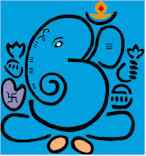 Swami
B. V. Tripurari, in
his book, "Ancient
Wisdom for Modern Ignorance", points out that, "Those
now disenchanted with industrialization and scientific materialism as well
as pseudo-spirituality, India's ancient spiritual heritage provides a rich
alternative. Eastern philosophy, and the devotional heart of India's
Vedanta in particular, can fill the empty shopping bag of our Western
accomplishments." Whoever reads the Bhagvad Gita for the first time
will be struck by the beauty and depth of this work. Swami
B. V. Tripurari, in
his book, "Ancient
Wisdom for Modern Ignorance", points out that, "Those
now disenchanted with industrialization and scientific materialism as well
as pseudo-spirituality, India's ancient spiritual heritage provides a rich
alternative. Eastern philosophy, and the devotional heart of India's
Vedanta in particular, can fill the empty shopping bag of our Western
accomplishments." Whoever reads the Bhagvad Gita for the first time
will be struck by the beauty and depth of this work.
Author Beatrice
Pitney Lamb has
noted: "Recently, increasing numbers of Westerners in revolt against
what they have found to be the shallow,
gadget-dominated, spiritually empty civilization of the West
have turned to "Hinduism" in search of greater meaning or
purpose in life. There is no doubt that the great Hindu tradition offers
profound spiritual insights, as well as techniques for attaining
self-realization, detachment, and even ecstasy.
(source: India:
A World in Transition - By Beatrice Pitney Lamb
p. 358).
W. J. Grant
wrote:
"India indeed has a preciousness which a materialistic age is in
danger of missing. Some day the fragrance of her thought will win the
hearts of men. This grim chase after our own tails which marks the present
age cannot continue for ever. The future contains a new human urge towards
the real beauty and holiness of life. When it comes India will be searched
by loving eyes and defended by knightly hands."
'The
religion of the Hindus is rich in legend and stupendous allegory. It is a
religion of great dignity and beauty. Its wrestlings with reality are as
courageous as any in the whole history of mankind..' Indian thought has
generally been contemplative, it has seldom been enamored of the material
side of life.'
(The
Spirit of India - By W. J. Grant
1933 p. vi - 58).
According to S.
Radhakrishnan, "In
the history of the world, Hinduism is the only religion, that exhibits a
complete independence and freedom of the human mind, its full confidence
in its own powers. Hinduism is freedom, especially the freedom in thinking
about God. "In
the search for the supernatural, it is like traveling in space without a
boundary or barrier." (source:
Bhagavad
Gita - By S.
Radhakrishnan pg
- 55).
 Hinduism
may not be called a religion in the sense other religions are known. It is
much more than a religion, it is a total way of life. Hinduism has no
founder. Its authority is Eternal
Truth.
The cumulative record
of metaphysical experimentation. Behind the lush tangle of religious
imagery, is a clear structure of thought. Compared to the rugged
originality of the Indian traditions, the language of today's philosophers
concerned with being often sound a little contrived. Hindus have always
been metaphysicians at heart. It is the underlying ideas, and not the
images which count. The forms are many, the reality is one. As stated at
the outset in the Rig Veda: Hinduism
may not be called a religion in the sense other religions are known. It is
much more than a religion, it is a total way of life. Hinduism has no
founder. Its authority is Eternal
Truth.
The cumulative record
of metaphysical experimentation. Behind the lush tangle of religious
imagery, is a clear structure of thought. Compared to the rugged
originality of the Indian traditions, the language of today's philosophers
concerned with being often sound a little contrived. Hindus have always
been metaphysicians at heart. It is the underlying ideas, and not the
images which count. The forms are many, the reality is one. As stated at
the outset in the Rig Veda:
"Truth
is one, the wise call it by various names."
 Hinduism is a monotheistic religion that springs from the Trinity (Trimurti).
Brahma, Vishnu, Shiva. Three aspects of one God. Creation, preservation,
destruction. Many in the west have tried to denounce it as the worship of
idols. Swami Vivekananda, said: "If a person wants to drink milk, he
uses a cup as he cannot drink it directly. Idols are nothing but symbols
through which divinity can be comprehended. It helps undeveloped minds to
grasp high spiritual truths.
Hinduism is a monotheistic religion that springs from the Trinity (Trimurti).
Brahma, Vishnu, Shiva. Three aspects of one God. Creation, preservation,
destruction. Many in the west have tried to denounce it as the worship of
idols. Swami Vivekananda, said: "If a person wants to drink milk, he
uses a cup as he cannot drink it directly. Idols are nothing but symbols
through which divinity can be comprehended. It helps undeveloped minds to
grasp high spiritual truths.
Lord
Krishna said:
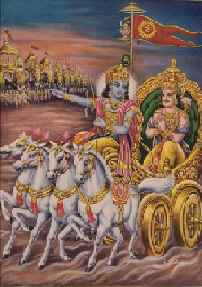
"In
whatever way men love Me, in the same way they find My love; various are
the ways of men, but in the end they all come to Me."
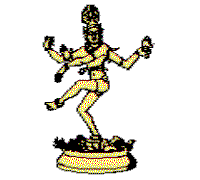 The
statue of Nataraja (dance pose of Lord Shiva) is a well known example for
the artistic, scientific and philosophical significance of Hinduism. The
dancing Shiva is the most sublime artistic attempt to capture the mystery
of the universe in form. The late scientist, Carl
Sagan, in his
book, "Cosmos"
asserts that the Dance
of Nataraja
(Tandava) signifies the
cycle of evolution and destruction of the cosmic universe (Big Bang
Theory). "It is the clearest image of the activity of God which any
art or religion can boast of." Modern physics has shown that the
rhythm of creation and destruction is not only manifest in the turn of the
seasons and in the birth and death of all living creatures, but also the
very essence of inorganic matter. The
statue of Nataraja (dance pose of Lord Shiva) is a well known example for
the artistic, scientific and philosophical significance of Hinduism. The
dancing Shiva is the most sublime artistic attempt to capture the mystery
of the universe in form. The late scientist, Carl
Sagan, in his
book, "Cosmos"
asserts that the Dance
of Nataraja
(Tandava) signifies the
cycle of evolution and destruction of the cosmic universe (Big Bang
Theory). "It is the clearest image of the activity of God which any
art or religion can boast of." Modern physics has shown that the
rhythm of creation and destruction is not only manifest in the turn of the
seasons and in the birth and death of all living creatures, but also the
very essence of inorganic matter.
For modern physicists, then, Shiva's dance is the dance of subatomic
matter. Hundreds of years ago, Indian artist created visual images of
dancing Shivas in a beautiful series of bronzes. Today, physicist have
used the most advanced technology to portray the pattern of the cosmic
dance. Thus, the metaphor of the cosmic dance unifies, ancient religious
art and modern physics. The Hindus, according to Sir
Monier-Williams,
were Spinozists more than 2,000 years before the advent of Spinoza, and
Darwinians many centuries before Darwin and Evolutionists many centuries
before the doctrine of Evolution was accepted by scientists of the present
age.
The French historian Louis
Jacolliot as
quoted by Galav in the "Philosophy
of Hinduism" page 17 says, "Here to mock are
conceit, our apprehensions, and our despair, we may read what Manu
said, perhaps 10,000 years
before the birth of Christ about Evolution:
' The first
germ of life was developed by water and heat.' (Book I, sloka 8,9 )
' Water ascends towards the sky in vapors; from the sun it descends in
rain, from the rains are born the plants, and from the plants, animals.'
(Book III, sloka 76).
According to the Gita, Creation has been under way from all
eternity as the spontaneous outpouring of the Lord's creative energy, as
the workings of his prakriti ( primordial Nature). Yet all this
spontaneity and freedom, so natural to God, has yet to be discovered and
realized by the numberless creatures involved in this process. (It is as
if Creation were playing hide-and -seek with itself).
 Hinduism
is a positive religion in which there are no infidels or heretics. It does
not look with contempt even upon an atheist. It doesn't approve of
proselytism as means of increasing the number of its adherents. It
contains no childish dogma of sin, superstition, fear, false hope
and damnation like other religions. The serpent which, in Christianity,
brought about the Fall of Man and became his lasting enemy, is in Hinduism
found entwined around the neck of Shiva, and as the couch upon which
Vishnu reclines. Hinduism
is a positive religion in which there are no infidels or heretics. It does
not look with contempt even upon an atheist. It doesn't approve of
proselytism as means of increasing the number of its adherents. It
contains no childish dogma of sin, superstition, fear, false hope
and damnation like other religions. The serpent which, in Christianity,
brought about the Fall of Man and became his lasting enemy, is in Hinduism
found entwined around the neck of Shiva, and as the couch upon which
Vishnu reclines.
In India,
science and religion are not opposed fundamentally, as they often seem to
be in the West, but are seen as parts of the same great search for truth
and enlightenment that inspired the sages of Hinduism, Buddhism, and
Jainism. Philosophy
and science both disputed Descartes' notions, and even the Church viewed
him as a threat to its authority. In fact, in 1663, the Church condemned
his books, but by then it was too late. Descartes reasoning helped bring
in the Age of Enlightenment throughout Europe and North America.
 Hinduism
comes before us as an old and authentic path, tested by many centuries of
human experience. With its respect for the earth and her bounty. It is
truly a joyous religion as those who have witnessed it during its many
festivals. It is
based on personal discovery. "Know thy self and be free." In
such an open laboratory, Hindu spirituality has grown over the millennia,
so diverse and rich, that it defies definition. If
the Indian mind went beyond form to the formless, it also reveled in a
riotous feast of forms - in a world of imagination. It has flourished in
exuberance... Hinduism
comes before us as an old and authentic path, tested by many centuries of
human experience. With its respect for the earth and her bounty. It is
truly a joyous religion as those who have witnessed it during its many
festivals. It is
based on personal discovery. "Know thy self and be free." In
such an open laboratory, Hindu spirituality has grown over the millennia,
so diverse and rich, that it defies definition. If
the Indian mind went beyond form to the formless, it also reveled in a
riotous feast of forms - in a world of imagination. It has flourished in
exuberance...
Klaus L.
Klostermaier professor
of Religious Studies at the University of Manitoba, Canada says in his
book, "A
Survey of Hinduism"
"Hinduism has proven much more open than any other
religion to new ideas, scientific thought, and social experimentation.
Many concepts like reincarnation,
meditation, yoga and
others have found worldwide acceptance. It would not be surprising to find
Hinduism the dominant religion of the twenty-first century. It would be a
religion that doctrinally is less clear-cut than mainstream Christianity,
politically less determined than Islam, ethically less heroic than
Buddhism, but it would offer something to everybody. It will appear
idealistic to those who look for idealism, pragmatic to the pragmatists,
spiritual to the seekers, sensual to the here-and-now generation.
Hinduism, by virtue of its lack of an ideology and its reliance on
intuition, will appear to be more plausible than those religions whose
doctrinal positions petrified a thousand years ago." But
man must go beyond the gratification of the senses. He must progress in
thought. This cannot come, says Sri
Aurobindo,
"if we chain the spirit to some fixed mental idea or system of
religious cult, intellectual truth, aesthetic norm, ethical value,
practical action... According
to M.
S. N. Menon, "For
the Hindus, we
are like pilgrims on a long march. Some are in the lead. They have lighted
torches in their hands. They are nearer to Bliss. Some are in the rear.
They are somewhat in the dark. They are still in the thrill of the senses.
And this is how it is going to be for ages. Before us is a great goal -
the progressive divination of men. Those who are at the rear will seek to
gratify their senses and those who are in the lead will raise their
consciousness.
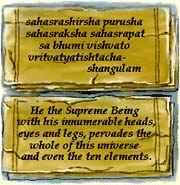 According
to Hans Torwesten,
in his book "Vedanta
- Heart of Hinduism": According
to Hans Torwesten,
in his book "Vedanta
- Heart of Hinduism":
" A fair number of leading physicists and biologists have found
parallels between modern science and Hindu ideas. In America, many writers
such as J. D.
Salinger (An
Adventure in Vedanta: J.D. Salinger's the Glass Family),
Henry
Miller, Aldous Huxley, Gerald Heard, and Christopher Isherwood, were
in contact with the Vedanta. Most of them came from elevated
intellectual circles which rejected the dogmatism of the Christian
Churches yet longed for spirituality and satisfactory answers to the
fundamental questions of existence. In Vedanta, they found a wide-open,
universal, and philosophically oriented religion where even the
penetrating scientific mind could find something to its taste".
European philosophers rhapsodized about the profundity and beauty of these
writings. Here they encountered a fusion of philosophy and religion, a
deep wisdom and a concern with the ultimate, that had no parallel in
either contemporary Western philosophy or Western religion. George
Feuerstein, in his
book ' Introduction
to the Bhagavad Gita: Its Philosophy and Cultural Setting' says:
" The ant-heap behavior of modern human society, with its
soul-destroying mechanical routine and organized aggression and violence,
is only one of the negative aspects of the present crisis. Thorough
discontentment with the inherited Western - Christian - tradition,
especially with the 'God out there' dogma, has kindled a large-scale
authentic search for truth in the 'heathen world', above all the spiritual
heritage of India. As
was to be expected after the disappointment with Christian Theism, it is
more the monistic school, like Advaita-Vedanta and Zen, which captivate
the interest of the disillusioned Westerner."
God is not dead in India and not a mere memory of the past. Numerous
"living gods" and "Incarnations" are everywhere in
India today. It is not poverty that you find here - its the absolute core
of a living faith so alien to Westernized minds that it can be seen
terrifying. Many people in the West have come to realize more and more
that organized and denominationalized Christianity (called Churchanity
by Hindus)
does not even represent the essence of Christianity, let alone that of
religion, a new broader, and looser understanding of religion is emerging
that approaches the Hindu notion of dharma.
Joseph
Campbell, was an
avid scholar of spiritual development, in his book Myths
to Live By states:
" We in the West have named our God, or rather, we have had the
Godhead named for us in a book from a time and place that are not our own.
And we have been taught to have faith not only in the absolute existence
of this metaphysical fiction, but also in its relevance to the shaping of
our lives." In the Great East, on the other hand, the accent is on
experience: on one's own experience, not a faith in someone else's." In
the Christian West, there was that Fall, back there, in the Garden, and we
have all been congenital sinners ever since." "Whereas in the
East there is the idea of the inherent innocence of Nature, even
in what appears to our human eyes and sentiments to be its cruelties, the
World, as they say in India, is God's Play (Maya).
It is a wondrous, thoughtless play: a rough play, the roughest, cruelest,
most dangerous, most difficult with no holds barred." (source: Myths
to Live By - Joseph Campbell p. 96).
According to Sri
Aurobindo, in
his book, "India's
Rebirth" (ISBN
2-902776-32-2) page 141, says:
 "The
mentality of the West has long cherished the aggressive and quite
illogical idea of a single religion for all mankind, a religion universal
by the very force of its narrowness, one set of dogmas, one cult, one
system of ceremonies, one array of prohibitions and injunctions, one
ecclesiastical ordinance. That narrow absurdity prances about as the one
true religion which all must accept on peril of persecution by men here
and spiritual rejection or fierce eternal punishment by God in other
worlds. This grotesque creation of human unreason, the parent of so much
intolerance, cruelty, obscurantism and aggressive fanaticism, have never
been able to take firm hold of the free and supple mind of India". "The
mentality of the West has long cherished the aggressive and quite
illogical idea of a single religion for all mankind, a religion universal
by the very force of its narrowness, one set of dogmas, one cult, one
system of ceremonies, one array of prohibitions and injunctions, one
ecclesiastical ordinance. That narrow absurdity prances about as the one
true religion which all must accept on peril of persecution by men here
and spiritual rejection or fierce eternal punishment by God in other
worlds. This grotesque creation of human unreason, the parent of so much
intolerance, cruelty, obscurantism and aggressive fanaticism, have never
been able to take firm hold of the free and supple mind of India".
To quote Sir
Sarvepalli Radhakrishnan,
" The intolerance of
narrow monotheism is written in letters of blood across the history of man
from the time when first the tribes of Israel burst into the land of
Canaan. The
worshippers of the one jealous God are egged on to aggressive wars against
people of alien cults. They
invoke divine sanction for the cruelties inflicted on the conquered. The
spirit of old Israel is inherited by Christianity and Islam, and it might
not be unreasonable to suggest that it would have been better for Western
civilization if Greece had molded it on this question rather than
Palestine. Wars of religion which are the outcome of fanaticism that
prompts and justifies the extermination of aliens of different creeds were
practically unknown in Hindu India."
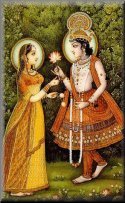 The
Vedas say that " the wise call the One by many names", and
exhort us to "let good thoughts come to us from everywhere"; in
the Bhagavad Gita, Lord Krishna assures the adherents of all religions
that "those who pray with devotion to another god, it is to Me that
they pray." The
Vedas say that " the wise call the One by many names", and
exhort us to "let good thoughts come to us from everywhere"; in
the Bhagavad Gita, Lord Krishna assures the adherents of all religions
that "those who pray with devotion to another god, it is to Me that
they pray."
Many
foreign groups of people persecuted for their religion came to seek refuge
in India. The Parsis have thrived. The heterodox Syrian Christians have
lived in peace until the Portuguese came to enlist them in their effort to
christianize India. The Jews have expressed their gratitude when they left
for Israel because India was the only country where their memories were
not of persecution but of friendly co-existence. All these groups were not
merely tolerated, but received land and material support for building
places of worship. Yuan
Chwang, the Chinese
traveler, reports that at the great festival of Prayaga, King Harsha
dedicated on the first day a statue to the Buddha, another to the sun, the
favorite deity of his father, on the second, and to Shiva on the third.
The famous Kottayam plates of Sthanuravi (ninth century AD) and the Cochin
plates of Vijayaragadeva bear eloquent testimony to the fact that the
Hindu kings not only tolerated Christianity but granted special
concessions to the professors of that faith. Today, The Tibetan Buddhist
and their spiritual head, the Dalai Lama have taken refuge in India, from
the persecution of Communist China.
Hinduism is
not a religion for occasional airings on Sundays or to be pulled out to
celebrate births, marriages and deaths. It is part of everyday activity.
To survive and flourish over a long period (over more than five millennia)
is a striking testimony to Hinduism's ability to adapt itself to changing
circumstances, an ability often insufficiently appreciated because of the
apparent dominance of traditional attitudes. Hinduism
is by definition (actually it defies definition) formless and seamless;
its beauty lies in its refusal to be contained, least of all by national
boundaries. Hinduism
continues to show amazing life and vigor. In all the historic encounters
between Hinduism and other religions Hinduism has always emerged the
stronger and richer and succeeded in absorbing the other elements.
According to Nirad
C. Chaudhuri: "
The faith which the Hindus had in their religion never wavered even in its
worst days. It has had waxings and wanings which has kept the balance
even." " In judging the vitality of Hinduism the point should be
emphasized that it has maintained itself through the ages and enforced
obedience to itself without support from any kind of organization, secular
or spiritual." (source: Hinduism:
a religion to live by - Nirad
C. Chaudhari p.
116-120)
Hinduism is an
inclusive faith, with many branches and many spiritual leaders, its
strength is the unity which underpins the diversity.
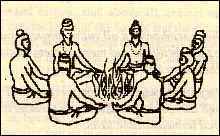 In conclusion, " Hinduism it is said, compares to the River Ganges,
which arises from the mighty Himalayas. She descends to the world of man
and of everyday life, bringing great floods of life-giving waters to the
plains. As she progresses, small tributaries and great streams join her,
swelling her volume and joining in her progress to her ultimate home, the
infinitude of the ocean. So it is with Hinduism. It is the oldest of the
great religions. Rather than a single doctrine or a single system of
worship it is a broad confluence of ideas and attitudes."
In conclusion, " Hinduism it is said, compares to the River Ganges,
which arises from the mighty Himalayas. She descends to the world of man
and of everyday life, bringing great floods of life-giving waters to the
plains. As she progresses, small tributaries and great streams join her,
swelling her volume and joining in her progress to her ultimate home, the
infinitude of the ocean. So it is with Hinduism. It is the oldest of the
great religions. Rather than a single doctrine or a single system of
worship it is a broad confluence of ideas and attitudes."
" Into the
bosom of the one great sea
Flow streams that come from hills on every side
Their names are various as their springs,
And thus in every land do men bow down
To one great God, though known by many names."
- (The Folk Songs
of Southern India By Gover
1871 p. 165)
[Back to
top]
 Did
You Know? Did
You Know?
Pythagorean Theorem was first
postulated by Indian mathematician - Baudhayana
 The
Formula known today as the Pythagorean Theorem was first postulated by
Indian mathematician - Baudhayana in the 6th century C.E. long before
Europe's math whizzies. In 497 C.E. Aryabhatta calculated the value of
"pi" as 3.1416. Algebra, trigonometry and the concepts of
algorithm, square root originated in India. Quadratic equations were
propounded by Sridharacharya in the 11th century. The
Formula known today as the Pythagorean Theorem was first postulated by
Indian mathematician - Baudhayana in the 6th century C.E. long before
Europe's math whizzies. In 497 C.E. Aryabhatta calculated the value of
"pi" as 3.1416. Algebra, trigonometry and the concepts of
algorithm, square root originated in India. Quadratic equations were
propounded by Sridharacharya in the 11th century.
The largest number used by Greeks and Romans were 106, whereas Hindus used
numbers as big as 10 to the power of 53, as early as 5000 BCE. Even
geometry called Rekha Ganita in ancient India, was applied to draft
mandalas for architectural purposes and for creating temple motifs.
Caste
"There is no superior caste. The Universe is the work of the Immense
Being. The beings created by him were only divided into castes according
to their aptitude."
- Mahabharata, Shanti Parva, 188
Transportation
 The
Rig Veda, the oldest document of the human race includes references to the
following modes of transportation: The
Rig Veda, the oldest document of the human race includes references to the
following modes of transportation:
Jalayan - a
vehicle designed to operate in air and water. (Rig Veda 6.58.3)
Kaara- a vehicle that operates on ground and in water. (Rig Veda 9.14.1)
Tritala- a vehicle consisting of three stories.(Rig Veda 3.14.1)
Trichakra Ratha - a three-wheeled vehicle designed to operate in the
air.(Rig Veda 4.36.1)
Vaayu Ratha- a gas or wind-powered chariot. (Rig Veda 5.41.6)
Vidyut Ratha- a vehicle that operates on power.(Rig Veda 3.14.1)
[Back to
top]
|

